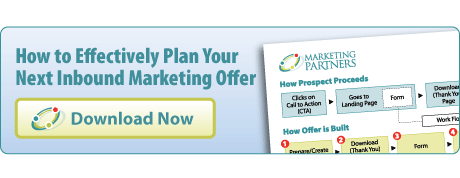
Inbound marketing is all about providing relevant content to your prospective customers with the goal of building relationships and ultimately, converting to sales. It doesn’t matter if you sell a product or service, sharing your knowledge is valuable — but where do you begin?
Think of planning your inbound marketing offers like preparing Thanksgiving dinner
With all the attention changing to the upcoming holidays, travel, and just how busy things seem to be in December, our team has been cranking out inbound projects every week. Recently my coworkers and I developed a process diagram to help with the planning. We all started with thinking about the end of the customer or prospect journey—rather like thinking about what you want a traditional Thanksgiving or Christmas dinner to be like at the table. We then reversed engineered the steps to a successful inbound offer just as you need to plan your dinner and which steps come first. For my household, making the deserts (apple and pumpkin pies) happens the day before the turkey goes in the oven. The stuffing is prepared before the turkey can go in the oven. The same is true for planning your inbound marketing offers, some pieces need to made to make the other pieces.
Content and offer
For the buyer or prospect, inbound marketing starts with your content and the offer. Imagine prospect Sarah searches for “vegan milk chocolate” and finds a web page or blog post that offers substitutes for animal milk to make milk chocolate. At the end of the page is an offer for a recipe to make homemade almond-milk chocolate. In this scenario, you’ve provided useful content our potential customer was searching for, and you’ve offered additional value. Now, a recipe doesn’t have significant cost to deliver, and certainly Sarah could search on almond-milk chocolate recipes and find approximately 681,000 search results on Google.
But, you’ve offered it right there, after demonstrating knowledge about non-animal-milk substitutes for making milk chocolate.
Working the inbound marketing process (backwards)
Now, if you are selling almond milk, chances are the recipe would have your brand specified as an ingredient. But, if you’re selling vegan chocolates you haven’t finished your offer. Sarah, your prospect, has read your page and given her name and email address to download the recipe and additional information about vegan almond milk chocolate. With this, you can send Sarah an email thanking her and offering more helpful information – such as where to order vegan almond milk chocolate and possibly other articles (web pages or blog posts) on working with chocolate or delicious chocolate flavors – such as salted caramel, which just happens to be my favorite.
We build the offer backwards. We start with the offer, the recipe in this example. We’ll use a photo on the recipe, and the same photo to make the call to action, landing page, and even thank you email. This builds continuity across the pieces for your prospect. When we have the offer, we can build the pages and other pieces that are used to complete the cycle.
Continue the dialog
You’ve started to communicate with Sarah, but you want to make it easy to expand and communicate with others. Link your social media to your content. Make it easy for others to like, share, pin, post, and tweet about you. Monitor your contacts list and keep in touch with customers and prospects. And most of all, deliver outstanding content and service to convert your customers to promoters.

[/fusion_builder_column][/fusion_builder_row][/fusion_builder_container]

